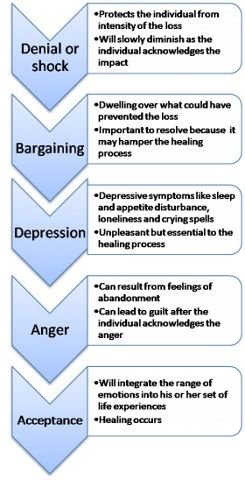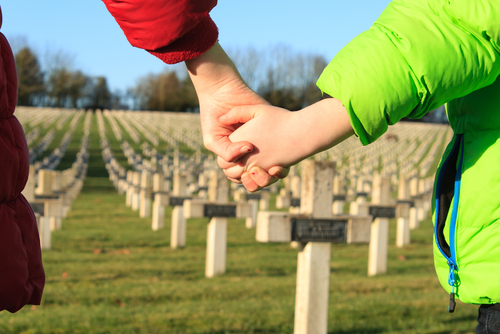Children are often the forgotten mourners after a loss. Adults may believe that children are not old enough to understand losses or that they do not have the depth of feeling that adults do. In actuality, even after the loss of a pet, children can mourn intensely, though their concepts of loss differ from those of adults according to their developmental level.
The most common losses during childhood are the separation or divorce of their parents (in which they often feel they are to blame), the loss of a grandparent (either because of a move away or death), the death of a sibling, or the death of a pet. Children should be encouraged to work through their loss, whether it is a "small death" or one that is catastrophic.
Elisabeth Kübler-Ross, pioneer researcher on death and dying, stated that dying people go through five stages:

Image source
Surrounding people should recognize what stage the person is in so they can provide optimum support.
In school, the teacher can do much to support the student and family by providing a trusting environment in which the child feels free to express himself or herself and by educating the class about issues surrounding dying and death. Listening is an important fecet of the teacher's role. Classmates might help by sending school-made cards and, if the circumstances warrants, attending the funeral. The teacher should be aware of cultural, ethic, and religious differences in beliefs and rituals surrounding death.
Suicide is a special case that requires special attention by school personnel because of the stigma that often surrounds taking one's own life. A situation that requires a special response is death within the school.
Activity:
Magical thinking: "If only I..."
Background information:
Magical thinking and egocentrism are normal developmental processes for growing children. They can bring problems with grieving, however, because children often blame themselves for the events causing death. They may feel guilty and believe they could have stopped the event "if only..." These beliefs are often shrouded in silence or tears as well as rage and anger, and it takes some artful open-ended questioning on the part of the adult to help children get beyond the unnecessary guilt, self-blame, and shame that result from magical thinking.
You will need:
- Easel
- markers
- bulletin board or display wall
Here's how:
Divide easel paper into two columns and add the headings "Accidents/Sickness" and "We feel". Using the easel to record responses, explain that people often get sick, have accidents, get hurt, and so on. Ask the question, "What are some things that cause accidents?" (Answers may include drunk drivers, carelessness, confusion, lack of order, mistakes.) Another question to ask is, "What are some things that cause sickness?" (Answers may include germs, smoking, drug abuse, allergies, genes, contaminated food, poor habits.)
After developing the list, ask the students how they feel when someone they love is hurt or gets sick. Record their responses on the easel under the "We feel" column (responses may include sad, scared, angry, guilty, ashamed). Define guilt and offer a personal experience so students will identify the feeling in themselves. (Example: "When my dog died five years ago, I felt guilty because I thought for while that I should have been home to take care of him, but I was at the movies with my friend.")
Ask the students to draw a picture that represents one of more of these life events of feelings. Display the pictures on a bulletin board with an appropriate title (for example, "Sometimes life is difficult").
Explain that we cannot control many things about life. No matter how much we wish or hope or pray, and no matter what we do, no human being can control life and death. List on another sheet of easel paper "Things we cannot control" (for example, the weather, sickness, the past, death). Ask students for suggestions, making sure to include other people's behavior (what other kids and adults do), death, and tragedy. List on easel paper "Things we can control", which will include our behavior, our thoughts, our habits, our tone of voice, and the way we react to our feelings, among others. Explain that sometimes people feel sad or guilty or angry because they are not so powerful. (We cannot stop Mom or Dad from abusing substances, we cannot change our families, we cannot stop divorce or fighting, o disease process, or death). We can get help from others when we feel sad. We can't change what has already happened, but we can ask for help.
Ask "Who can help?". Develop a list of helpers available to students, including in-school and out-of-school resources. Bear in mind that grieving parents may be unavailable for their children, therefore other adults are important alternatives for help. Younger students could draw pictures of the resource personnel for the bulletin board.

Image source
Follow up:
The easel paper of a bulletin board could be displayed during the year as a reminder of the sources of help for difficult situations.
In my next post, I will give an activity as a follow-up from this one, named, Seed to Flower, Cocoon to Butterfly, Egg to Chick, Life to Death.





This is something we all see in our lives and actually, at times of loss of relatives and at the times of dying, the younger childs do cry a lot and their mourning is unmatched to the adults.
I personally, witnessed that, and I think,adults do have the capacity to suppress their woes, but when it comes to children, they dont find that easy to take.
Thats a good piece of write, and I liked the way you presented the whole concept.
Take my grretings, 👍
Your content has been voted as a part of Encouragement program. Keep up the good work!
Use Ecency daily to boost your growth on platform!
Support Ecency
Vote for new Proposal
Delegate HP and earn more
Congratulations @ghostgtr! You have completed the following achievement on the Hive blockchain and have been rewarded with new badge(s):
Your next target is to reach 250 posts.
You can view your badges on your board and compare yourself to others in the Ranking
If you no longer want to receive notifications, reply to this comment with the word
STOPTo support your work, I also upvoted your post!
Check out the last post from @hivebuzz: